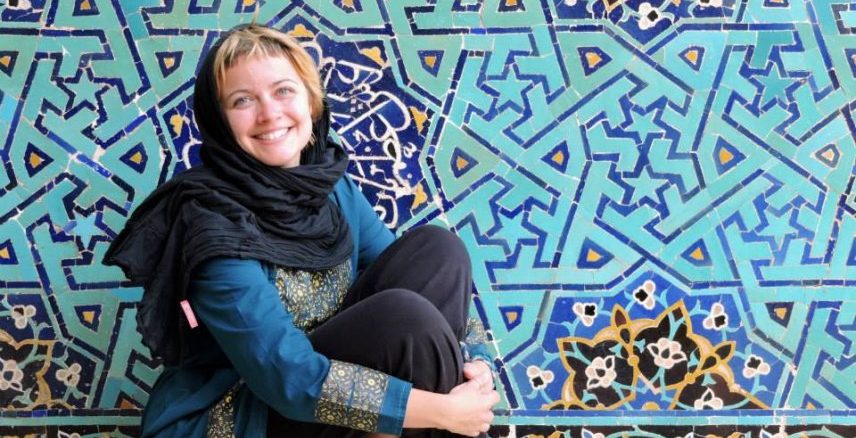
When I made the decision to go to Iran on my own and as a woman, the reactions I had from friends and family varied from amusement to concern and downright fear on my behalf. I was given an assortment of different things to do and say at Iranian immigration and while travelling, so as not to “get into trouble”.
Travelling as a woman isn’t without its discomforts. Female travellers must wear headscarves at all times. I have to be careful about where I walk and try not to walk down too many dark alleys or into any awkward situations. But once aware of the surrounding culture, it’s smooth sailing.
As a dual Philippine and Australian national, I’m eligible for a visa on arrival, but to be on the safe side, I applied for it in advance. It took a month, but there were no hiccups (aside from the time it took). On my arrival in Shiraz airport, I worked up a sweat practising my responses to all the possible questions I could be asked. However, once at the immigration desk, it’s a quick glance up, smile and an “Enjoy Iran” – and I’m on my way in.
For those travelling on British and American passports, however, the process is a lot harder. They’re required to travel with a government-appointed guide, who will report in every day to make sure the visitors are staying put on the tourist track.
Shiraz
Shiraz is known as the City of Poets, and it’s not hard to see where they draw their inspiration from. I visit the colourful Nasir Al-Mulk Mosque in the morning, when its stained-glass windows create a reflection that dances on the floor. In the afternoon, I retreat into the luscious garden dedicated to one of the city’s famous poets, Hafiz, where Iranian ballads play softly from loudspeakers and fans gather in clusters to celebrate his poetry. I explore the alleyways of its bazaar, where carpet sellers doze on their piles of wares, the scent of different spices assail me at every corner and antique gems glisten invitingly from dusty shop windows.
It’s an easy enough city to get around on foot, but in the heat of the day, I was more than happy to spend a few rials on short taxi rides between places. I find taxis in most cities easy to flag down, and if you know your destination well enough, there are no issues. Everywhere I travel, people’s curiosity gets the better of them – I’m bombarded with a series of questions, mostly about my impressions of Iran.
The star attraction of the area is the crumbling desert city of Persepolis, 70 kilometres away. While it has now mostly been engulfed by sand and buffeted by the harsh desert wind, the ceremonial capital of the ancient Achaemenid Empire still manages to hold an air of majesty fit for the many members of royalty that once passed through its gigantic doors. Stories of the great feasts that were once held there are depicted across its fragmented walls. Wall carvings of men arriving from all corners of the ancient world, bringing with them gifts from their home country, demonstrate the reach of this ancient empire.
Having had my fill of ancient carvings, I hop on the six -hour night bus to take me to my next destination, Yazd. While the buses are mixed-sex, the conductors are very conscious to make sure the single women are grouped together and aren’t sat next to a man. Surrounded by a group of inquisitive women, I spend most of my time in stimulating conversation about why there are so few tourists in Iran, shopping and where I’m from.
Yazd
My next stop is the desert town of Yazd, one of the best-preserved desert towns in the Islamic world. Its dusty, sand-coloured alleyways are a stark contrast to the architectural elegance of Shiraz. Here, the buildings sacrifice opulence for practicality. Beige domes and lofty wind towers act as natural air conditioners.
As the day heats up, I retreat inside the many hammam-style cafes, to sip on tea and read. I make my way out as the sun’s harsh rays beat down, getting lost in the meandering alleyways.
Old caravanserais dot the city and the towns around it hark back to the days of long-distance travel when camel trains and thirsty travellers traipsing along the old Silk Road would need a place to rest for a night. Evidence of affluence stemming from the ancient royal Qajar era can still be still be admired in their crumbling palaces, some of which have been restored and function as boutique hotels.
My accommodation, the Silk Road Hotel, is located in the middle of the old quarter, and also took the form of a traditional caravanserai. Nearby, I can see the glowing lights of the Jameh (Friday) Mosque and its two long, elegant minarets that light up in an aquamarine blue as the sun descends.
Yazd is the centre of Zoroastrian culture, a religion that was prevalent across Iran before the Muslim conquest, which converted the majority of the country to Islam. While the religion has now been reduced to small communities around the country, their funerary towers, known as the Towers of Silence, can still be seen perched on hills. Until the 1960s, these lonesome towers were used as a place where Zoroastrians would put their dead to be exposed to the elements and slowly picked apart by vultures. Another long-standing relic of this ancient religion is the fire temple, with a flame that’s said to have been kept alive since 470AD.
Isfahan
After soaking up the desert culture of Yazd, I make my way to the more illustrious city of Isfahan. To save time, I jump on the night bus again for the five-hour journey. The buses are comfortable and cosy, making it an easy transition.
The city’s main sites are centred around Imam Square, a majestic square bordering the maze-like Bozorg bazaar. It’s anchored on both ends by the Sheikh Lotfollah Mosque, the Masjid-e Imam Mosque and the seven-storey Ali Qapu Palace, the old residence of the Safavid kings.
The sublime Imam or Blue Mosque was built over 26 years in the early 17th century. It’s made up of 18 million bricks and 475,000 tiles, glazed in a palette of blues. I spend hours soaking up the intricate designs on the walls and ceilings.
A night-time stroll along the streets of Isfahan reveals a bustling scene, with throngs of families queuing for ice cream and sickly sweet flavoured ice drinks, exploring the shops or congregating in the city’s many parks. A dried-up riverbed runs through the city, crossed by a series of stylish bridges.
I spend one day walking across its different sites, admiring the arches of the bridges, picnicking along with other families in the parks that line the river and visiting the Vank Cathedral in the Armenian Quarter. According to accounts, Armenians came to ancient Persia fleeing the Ottoman Empire’s persecution. They were known as great tradesmen, especially for silk, so the then-ruling Shah Abbas welcomed their settlement. The cathedral, along with an on-site museum, provides an interesting insight into the plight of the Armenians, their culture and their history. The main attraction of the museum is a strand of hair which has a verse from the Old Testament engraved on it with a diamond-tipped pen.
This time, I mix it up and take the night train (another six-hour journey) to Tehran. It’s on these long trips between cities that I have the best conversations with locals. I’m put in a sleeper carriage with four plump, gossiping middle-aged ladies who almost don’t let me go to sleep with all the questions they have about my experience in Iran.
Tehran
I save the sprawling metropolis of Tehran as my last stop. Having taken in Iran’s architectural jewels, I was ready to dig into big-city life. While Tehran remains the traditional centre of political power and is, in general, a conservative city, it’s also home to some of Iran’s most liberal communities. The Park-e Honar or Artists Park, which houses the Iranian Artists Forum, shows me a different side of the country: I see funky headscarves and chunky jewellery. As a stark contrast, the now closed American embassy, where paintings showing anti-American slogans adorn the walls, is just round the corner. This is where the Iran hostage crisis took place in 1979.
What interests me the most about Tehran are the many museums that dot the place, particularly the National Jewels Museum, which is kept under heavy security in a vault beneath the Central Bank of Iran. Among its treasures are the 182-carat Darya-e Nur diamond and the emerald, sapphire- and pearl-studded Peacock Throne, stolen by one of the shahs from a Mughal emperor, used to seat the royalty of the Qajar Empire. It gives a glimpse into the country’s opulent past.
One thing that I take away from the country is the friendliness of the people. Throughout the two weeks I spend travelling around Iran, there are so many instances of kindness and unwavering hospitality. Even though I’m travelling on my own, I never feel truly alone. While waiting for a train or eating in a restaurant, someone will always strike up a conversation about anything from Iranian literature to football or food. If Iran becomes more open to different nationalities, the kindness and generosity of its people, along with the variety of landscape and rich history and culture, will make it an easy sell.
by Aya Lowe
